Others
Mild hydrolysates of allosamidin were analyzed using Asahipak ES-502C 7C (a column for weak cation exchange chromatography).
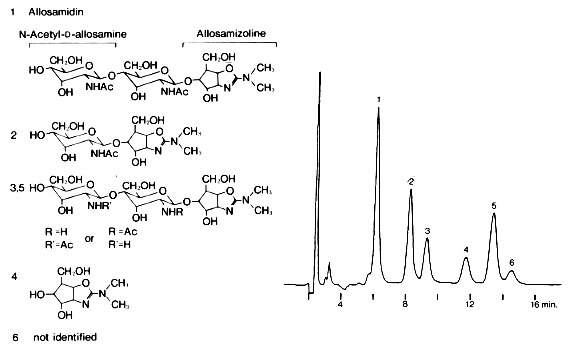
Sample : Mild hydrolysates of allosamidin
Column : Shodex Asahipak ES-502C 7C (7.5mmID*100mm) Eluent : 10mM Ammonium acetate buffer(pH9.1) Flow rate : 1.0mL/min Detector : UV(210nm) Column temp. : 40deg-C
5-(Hydroxymethyl)furfural (5-HMF) in fruit juice was analyzed using Asahipak ODP-50 6D (a column for reversed phase chromatography .

Sample : 5-(Hydroxymethyl)furfural, 5-HMF in Fruit juice
100% Natural orange juice
100% Natural grape juice
Column : Shodex Asahipak ODP-50 6D (6.0mmID*150mm) Eluent : 50mM Sodium phosphate buffer(pH3.0)/CH3CN=90/10 Flow rate : 1.0mL/min Detector : UV(283nm) Column temp. : 50deg-C
Arsenic compound in marine life were analyzed using Asahipak GS-220 7G (a multimode column).
GS-220 7G is an old type of GS-220 HQ.
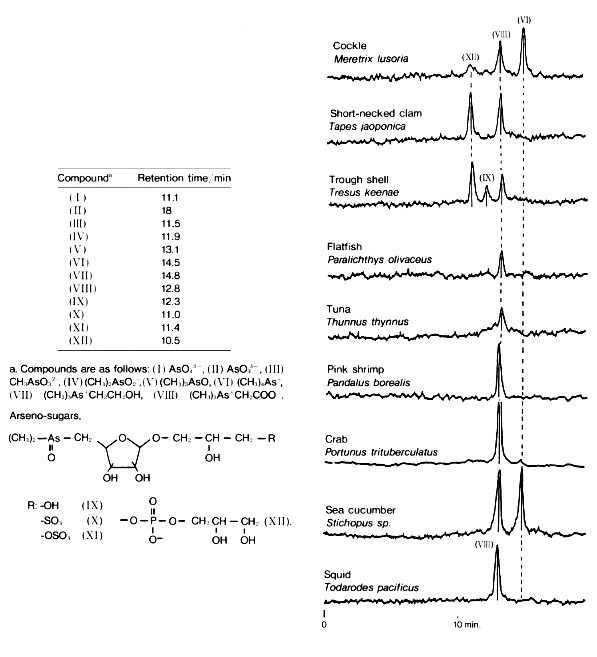
Sample : Arsenic compounds
Column : Shodex Asahipak GS-220 7G (7.5mmID*500mm) Eluent : 50mM Sodium phosphate buffer(pH6.8) Flow rate : 1.0mL/min Detector : Atomic absorption detector
M.Morita and Y.Shibata, Anal.Sci., 3 (1987) 575.
RSpak NN-614 is packed with poly(hydroxymethacrylate) bonded with trace amounts of sulfo groups, and the main separation mode is the reversed phase mode. However, due to the sulfo groups, ion interaction also works. Acidic substances are separated by ion exclusion mode and elute faster. Neutral substances are separated by reversed phase and alkaline substances are separated by a mixture of reversed phase (in the case of hydrophobic structure) and ion exchange mode. Therefore, the elution order is basically as follows: first the acidic, then the neutral and finally the alkaline substances. The column is suited to the analysis of mixture of acidic, neutral and alkaline substances.

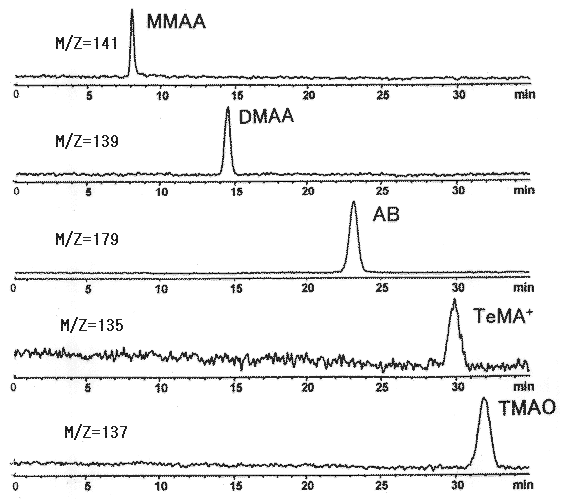
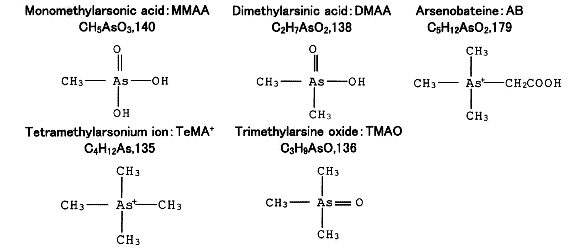
Sample : Arsenic compounds,(Above) 100ppm each, (Below) 10ppb each, 20micro-L
Monomethylarsonic acid, MMAA
Dimethylarsinic acid, DMAA
Arsenobetaine, AB
Tetramethylarsonium, TeMA
Trimethylarsine oxide, TMAO
(HPLC)
Instrument : Agilent 1100
Column : Shodex RSpak NN-614 (6.0mmID*150mm)
Eluent : 8mM HNO3/5mM NH4NO3 aq.
Flow rate : 0.4mL/min
Column temp. : 40deg-C
(MS)
Instrument : Agilent 1100MSD
Mass range : (Above): TIC 100-1000(m/z)
(Below): SIM
Ionization : Electrospray
Polarity : Positive
Fragmentor : 80V
Nebulizer : N2(60psi)
Drying gas : N2(10L/min, 350deg-C)
RSpak NN-614 is packed with poly(hydroxymethacrylate) bonded with trace amounts of sulfo groups, and the main separation mode is the reversed phase mode. However, due to the sulfo groups, ion interaction also works. Acidic substances are separated by ion exclusion mode and elute faster. Neutral substances are separated by reversed phase and alkaline substances are separated by a mixture of reversed phase (in the case of hydrophobic structure) and ion exchange mode. Therefore, the elution order is basically as follows: first the acidic, then the neutral and finally the alkaline substances. The column is suited to the analysis of mixture of acidic, neutral and alkaline substances.
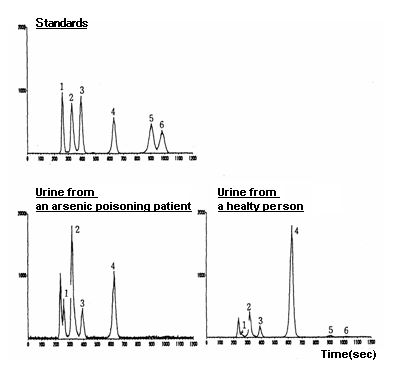
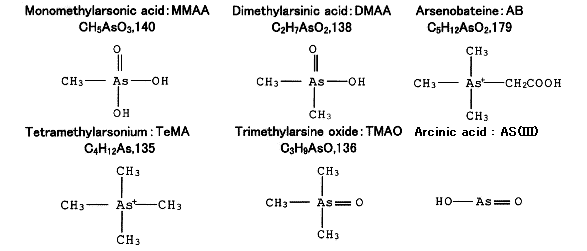
Sample : Arsenic compounds, 50micro-L
1. Monomethylarsonic acid, MMAA
2. Arsinic acid, As(III)
3. Dimethylarsinic acid, DMAA
4. Arsenobetaine, AB
5. Tetramethylarsonium, TeMA
6. Trimethylarsine oxide, TMAO
Sample : 10-fold diluted Urine, 50micro-L
*Arsenic acid (As(V)) was detected before MMAA in the urine sample.
(HPLC) Instrument : Agilent IC 7000 Column : Shodex RSpak NN-614 (6.0mmID*150mm) Eluent : 5mM HNO3/8mM NH4NO3 aq. Flow rate : 0.8mL/min (MS) Instrument : Agilent 4500 IC-ICP-MS Mass range : SIM (m/z=75)
(Reference)
Noriko Tsunoda,
Pharmacia. 1998, vol.34, no.12, p.1237-1241.
Dialkyltin compounds were analyzed using Asahipak GS-310 7E (a multimode column).
GS-310 7E is an old type of GF-310 HQ.
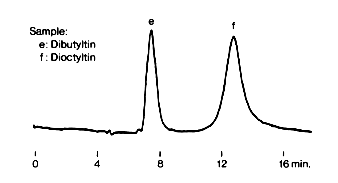
Sample :
e. Dibutyltin
f. Dioctyltin
Column : Shodex Asahipak GS-310 7E (7.5mmID*250mm) Eluent : 0.01M KH2PO4 buffer(pH2.0)/CH3OH=40/60 Reagent : 0.005% Morin in CH3OH (for post column reaction) Flow rate : (Eluent); 1.0mL/min, (Reagent); 0.5mL/min Detector : Fluorescence(Ex. 420nm, Em. 500nm)
H.Nakajima et al.,BUNSEKI KAGAKU, 36 (1987) 867
Cyanate and carbamyl phosphate were analyzed using Asahipak ES-502N 7C (a column for weak cation exchange chromatography).
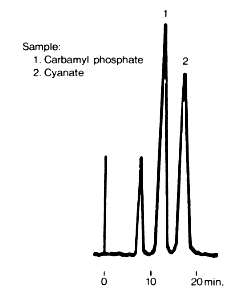
Sample : 20micro-M each, 50micro-L
1. Carbamyl phosphate
2. Cyanate
Column : Shodex Asahipak ES-502N 7C (7.5mmID*100mm)
Eluent : 0.15M NaCl aq.
Reagent : (I); 0.1M acetate buffer(pH3.0) containintg 2%(w/v) Phenol
and 10mg/dL Sodium nitropreusside
(II); 1.0%(w/v) Sodium hydroxide containing 0.1%(w/v) Sodium hypochlorite
(for hydrolysis under acidic condition/indophenol reaction)
Flow rate : 1.0mL/min
Detector : VIS(635nm)
Column temp. : 20deg-C
I.Koshiishi et al., Anal.Sci., 2 (1986) 81.
Paraquat and diquat were analyzed using Asahipak ES-502C 7C (a column for weak cation exchange chromatography).
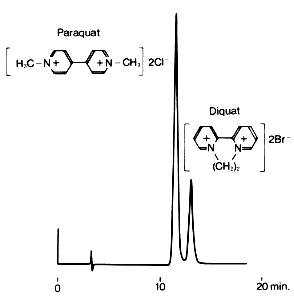
Column : Shodex Asahipak ES-502C 7C (7.5mmID*100mm) Eluent : 50mM Sodium phosphate buffer(pH7.0) + 150mM NaCl Flow rate : 1.0mL/min Detector : UV(288nm) Column temp. : 30deg-C
Paraquat in rat serum was analyzed using Asahipak GS-320 7G (a multimode column).
GS-320 7G is an old type of GS-320 HQ.
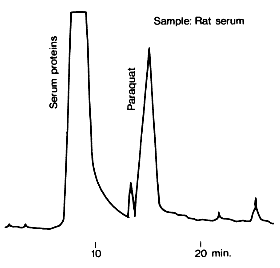
Column : Shodex Asahipak GS-320 7G (7.5mmID*500mm) Eluent : 50mM Phosphate buffer(pH7.2)/CH3OH=80/20 + 0.2M NaCl Flow rate : 1.0mL/min Detector : UV(254nm) Column temp. : 40deg-C
Courtesy of Dr.Chiba, Nihon University
Polyphosphates were separated using OHpak SB-802.5 HQ (a column for GFC separation).

Sample : Polyphosphates
1. Sodium tripolyphosphate, Na5P3O10
2. Sodium pyrophosphate, Na4P2O7
3. Sodium phosphate monobasic, NaH2PO4
4. NaCl
Column : Shodex OHpak SB-802.5 HQ (8.0mmID*300mm) Eluent : 50mM NaCl aq. Flow rate : 0.5mL/min Detector : Shodex RI Column temp. : 70deg-C
Polyphosphates were analyzied using 2 pieces of Asahipak GS-220 HQ.
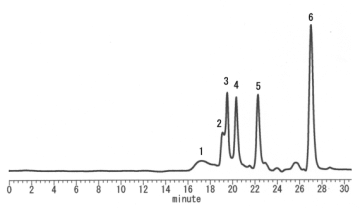
Sample : Polyphosphates
1. Sodium methaphosphate, (NaPO3)n
2. Sodium tetrapolyphosphate, Na6P4O13
3. Sodium triphosphatec, Na5P3O10
4. Sodium pyrophosphate, Na4P2O7
5. Sodium phosphate tribasic, Na3PO4
6. NaCl
Columns : Shodex Asahipak GS-220 HQ (7.5mmID*300mm) x 2 Eluent : 50mM NaCl aq. Flow rate : 0.6mL/min Detector : Shodex RI Column temp. : 60deg-C
Polyphosphates (Sodium methaphosphate) were analyzied using 2 pieces of Asahipak GS-220 HQ.

Sample : Polyphosphates, 30micro-L
Sodium methaphosphate, (NaPO3)n
Columns : Shodex Asahipak GS-220 HQ (7.5mmID*300mm) x 2 Eluent : 50mM NaCl aq. Flow rate : 0.6mL/min Detector : Shodex RI Column temp. : 60deg-C
Hydrogen peroxide is used as a sanitizer and a disinfectant in the food industry. Here, hydrogen peroxide was analyzed using a SUGAR KS-801 (a column for GFC separation) and an electrochemical detector (ECD).
(A) shows the detection of hyrogen peroxide alone. The peak of hydrogen peroxide can be seen at 21.2 minutes. The small peak at 16.8 minutes is considered to be an impurity in hydrogen peroxide.
(B) shows the chromatogram of simultaneous analysis of ascorbic acid and hydrogen peroxide.
(C) shows the autoxidation of ascorbic acid. The quantitaion was done using HPLC detection. (B) is the chromatogram at 3 hours in (C).
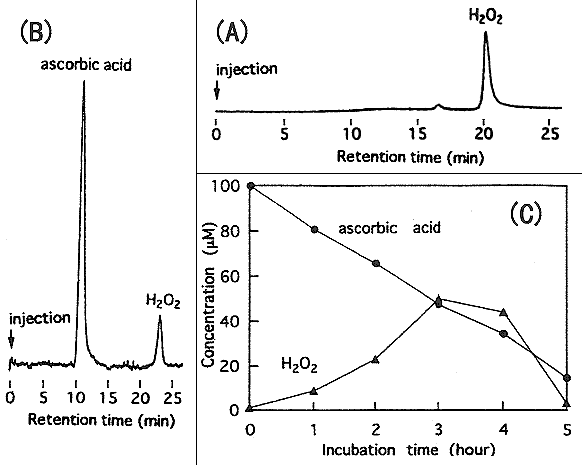
Sample :
Hydrogen peroxide
Ascorbic acid
Column : Shodex SUGAR KS-801 (8.0mmID*300mm) Eluent : H2O Reagent : 10mM Na2SO4 + 10 micro-M EDTA-2Na aq. Flow rate : (Eluent); 0.6mL/min, (Reagent); 0.15mL/min Detector : ECD(Electrode; Pt, 500mV vs Ag/AgCl) Column temp. : 40deg-C
Takahashi et al., Analytycal Sciences, 15 (1999) 481
Chelating reagents were analyzed using IC I-524A (a column for ion chromatography ).
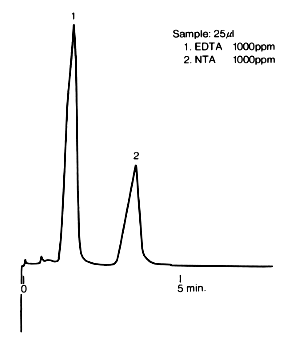
Sample :
1. Ethylenediaminetetraacetic acid, EDTA
2. NTA, Nitrilotriacetic acid
Column : Shodex IC I-524A (4.6mmID*100mm) Eluent : 1.5mM H2SO4 aq. Flow rate : 1.2mL/min Detector : UV(210nm) Column temp. : 40deg-C
EDTA and NTA were separated with the ion chromatography column NI-424.The calibration curve derived from the chromatograms for the concentrations 20mg/L,50mg/L,100mg/L showed a good linearity.
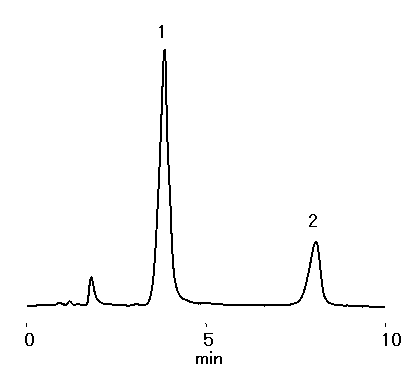
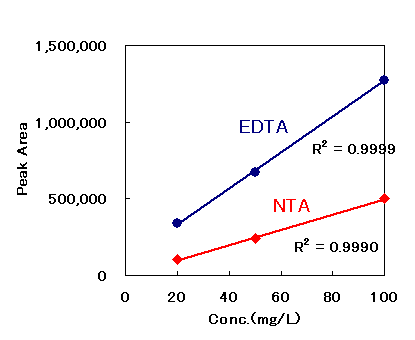
Sample : 100micro-L
1. Ethylenediaminetetraacetic acid, EDTA 20mg/L
2. Nitrilotriacetic acid, NTA, 20mg/L
Column : Shodex IC NI-424 (4.6mmID*100mm) Eluent : 2mM H2SO4 aq. Flow rate : 1.0mL/min Detector : UV(210nm) Column temp. : 40deg-C
Chelating compounds were analyzed with Asahipak ODP-40 4D (a column for reversed phase chromatography).
(Sample preparation)
The chelating agents were dissolved into 10mM sodium bicarbonate and 10mM sodium carbonate aqueous solution whose pH is adjusted to 11.1 by tetrabutyl ammonium hydroxide. After the adjustment of pH, the surplus amount of 0.01M iron chloride solution was added for making chelating compounds.

Sample : 100ppm each, 10micro-L
1. (2-Hydroxyethyl)ethylenediamine-N,N’,N’-triacetic Acid, HEDTA
2. Ethylenediaminetetraacetic acid disodium salt, EDTA
3. Diethylenetriaminepentaacetic acid dianhydride, DTPA
Column : Shodex Asahipak ODP-40 4D (4.6mmID*150mm)
Eluent : 10mM Na2CO3 + 10mM NaHCO3
+ 10mM Tetrabutylammonium Hydroxide (pH7.0 adjusted with 1M of HCl)
Flow rate : 0.8mL/min
Detector : UV(254nm)
Column temp. : 40deg-C
Five kinds of hidantoins were analyzed using RSpak DE-613 with aqueous eluent. The elution order of the hidantoins is the order of hydrophilicity of R-group.
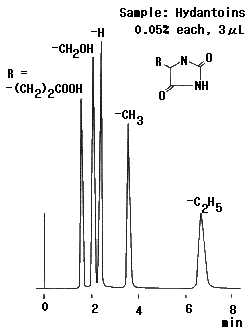
Sample : Hydantoins, 0.05% each, 3micro-L
1. 5-Carboxyethyl Hydantoin
2. 5-Hydroxymethyl Hydantoin
3. Hydantoin
4. 5-Methyl Hydantoin
5. 5-Ethyl Hydantoin
Column : Shodex RSpak DE-613 (6.0mmID*150mm) Eluent : 1/30M Na2HPO4 + 1/30M KH2PO4 aq. Flow rate : 2.0mL/min Detector : UV(210nm) Column temp. : 50deg-C
Three reversed phase columns RSpak DM-614, DE-613 and DS-613 were used for the analysis of alkylamides. For this sample, DM-614 is not suited because of too high polarity of its packing material, and, DS-613 is also not suited because of too long elution time. DE-613 is best suited for this sample.

Sample : Amides
1. Acetamide
2. Propionamide
3. Butylamide
4. Valeramide
Columns : (A); Shodex RSpak DM-614, (B); DE-613, (C); DS-613 (6.0mmID*150mm each) Eluent : H2O/CH3OH=70/30 Flow rate : 1.0mL/min Detector : UV(210nm) Column temp. : 35deg-C
In order to separate hydrophilic compounds, water or 100% buffer solution is used as the eluent, however, such eluent usually shorten the column life of ODS columns. Since the packing material of RSpak DE-413 is chemically stable and has long column life. The stable analysis results can be obtained using DE-413 even when 100% aqueous solution is used as the eluent.

Sample : Amides 0.2% each, 10micro-L
1. Formamide
2. Acetamide
3. Propionamide
Column : Shodex RSpak DE-413 (4.6mmID*150mm) Eluent : 10mM H3PO4 aq. Flow rate : 1.0mL/min Detector : Shodex RI Column temp. : 50deg-C
IIn order to separate hydrophilic compounds, water or 100% buffer solution is used as the eluent, however, such eluent usually shorten the column life of ODS columns. Since the packing material of RSpak DE-413 is chemically stable and has long column life. The stable analysis results can be obtained using DE-413 even when 100% aqueous solution is used as the eluent.
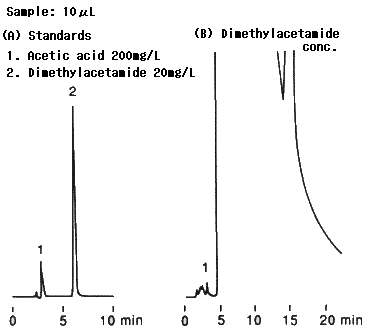
Sample : Amides, 10micro-L
1. 200mg/mL Acetic acid
2. 20mg/mL Dimethylacetamide
Column : Shodex RSpak DE-413 (4.6mmID*150mm) Eluent : 10mM Sodium phosphate buffer(pH5.0) Flow rate : 1.0mL/min Detector : UV(210nm) Column temp. : 40deg-C
In order to separate hydrophilic compounds like amides, water or 100% buffer solution is used as the eluent, however, such eluent usually shorten the column life of ODS columns. Since the packing material of RSpak DE-413 is chemically stable and has long column life. The stable analysis results can be obtained using DE-413 even when 100% aqueous solution is used as the eluent.
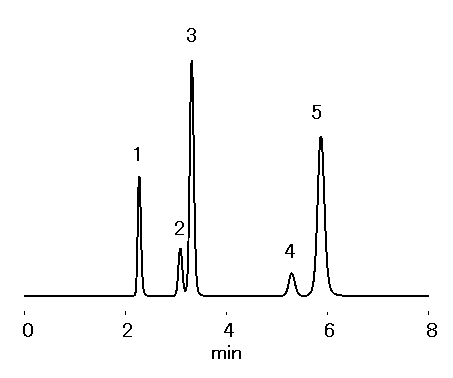
Sample : Amides, 10micro-L
1. Acetamide 100mg/L
2. Propionamide 100mg/L
3. Acrylamide 10mg/L
4. n-Butylamide100mg/L
5. Methacrylamide 10mg/L
Column : Shodex RSpak DE-413 (4.6mmID*150mm) Eluent : 10mM H3PO4 aq. Flow rate : 1.0mL/min Detector : UV(210nm) Column temp. : 50deg-C
In order to separate hydrophilic compounds, water or 100% buffer solution is used as the eluent, however, such eluent usually shorten the column life of ODS columns. Since the packing material of RSpak DE-413 is chemically stable and has long column life. The stable analysis results can be obtained using DE-413 even when 100% aqueous solution is used as the eluent.
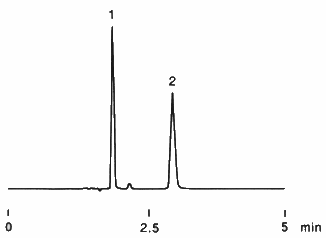
Sample : 5micro-L
1. Formaldehyde 5micro-L/mL (35%)
2. Acetaldehyde 2micro-L/mL (90%)
Column : Shodex RSpak DE-413 (4.6mmID*150mm) Eluent : 10mM H3PO4 aq. Flow rate : 1.0mL/min Detector : Shodex RI Column temp. : 50deg-C
Lecithin from soybean was analyzed using Asahipak GF-310 HQ.
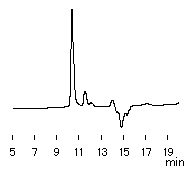
Sample : Lecithin from soybean
Column : Shodex Asahipak GF-310 HQ (7.5mmID*300mm) Eluent : THF Flow rate : 0.6mL/min Detector : Shodex RI Column temp. : 30deg-C
L-alpha-phosphatidylethanolamine (dioleoyl) was analyzed using Asahipak GF-310 HQ.
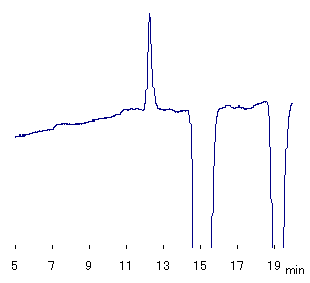
Sample : L-alpha-Phosphatidylethanolamine, Dioleoyl
Column : Shodex Asahipak GF-310 HQ (7.5mmID*300mm) Eluent : THF Flow rate : 0.6mL/min Detector : Shodex RI Column temp. : 30deg-C
Five kinds of haloacetic acid were analyzed with RSpak JJ-50 2D.
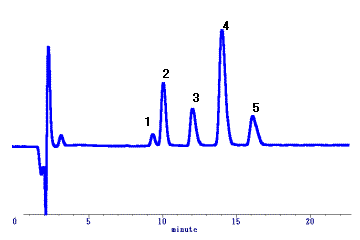
Sample : 500ppm each, 2micro-L
1. Chloroacetic acid
2. Bromoacetic acid
3. Dichloroacetic acid
4. Dibromoacetic acid
5. Trichloroacetic acid
Column : Shodex RSpak JJ-50 2D (2.0mmID*150mm) Eluent : 25mM CH3COONH4 buffer(pH9.2)/CH3CN=50/50 Flow rate : 0.2mL/min Detector : UV(210nm) Column temp. : 40deg-C
Polycyclic Aromatic hydrocarbons (PAHs) such as Benzo[a]pyrene existing in the air are known as the carcinogen or mutagen. Recentry, it developed that Nitro-polycyclic aromatic hydrocarbon (NPAH), which in one of carcinogen, is in also existing in the air. And the carcinogens and mutagens come from diesel dust. The following application data shows that the separation of carcinogens existing in the diesel dust with using GPC clean up column, CLNpak PAE-800 AC column.

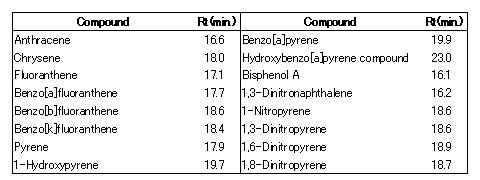
Sample :
1. Bisphenol A
2. Benzo[a]fluoranthene
3. 1,3-Dinitropyrene
4. Benzo[a]pyrene
5. Hydroxybenzo[a]pyrene mixture
Column : Shodex CLNpak PAE-800 AC (8.0mmID*300mm) Eluent : Acetone Flow rate : 0.8mL/min Detector : UV(210nm) Column temp. : Room temp.
Courtesy of Dr. Kazuichi Hayakawa, Faculty of Pharmaceutical Science, Kanazawa University
The pretreatment of polychlorinated biphenyls (PCBs) analysis in wate oil was considered using CLNpak PAE-2000 AC.
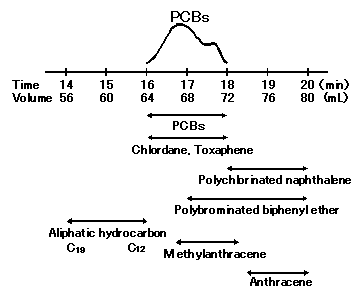
Sample : PCBs, Polychlorinated biphenyls
Columns : Shodex CLNpak PAE-G (8.0mmID*50mm) + PAE-2000 AC (20.0mmID*300mm) Eluent : Acetone Flow rate : 4.0mL/min Detector : UV(213nm)
Data provided of Mr. Koichi Sasaki, Analytical Center. Kokan Keisoku Corporation.
Polymer-based reversed-phase semi-micro column, DE413-2B was used with LC/MS detector to quantify 7 kinds of diarrheic and lipid-soluble shelfish poisons. Generally, mouse has been used for the shellfish poisoning testing, but alternative testing method was required due to animal testing’s long analysis time, low repeatability, and animal right view of points. The LC/MS method is rapid and also determines the compounds that are difficult to be detected using animal testing. DE413-2B can be used in a wide pH range (2-11) with a flexible solvent selection (any portion of 100% water to 100% selected organic solvent).
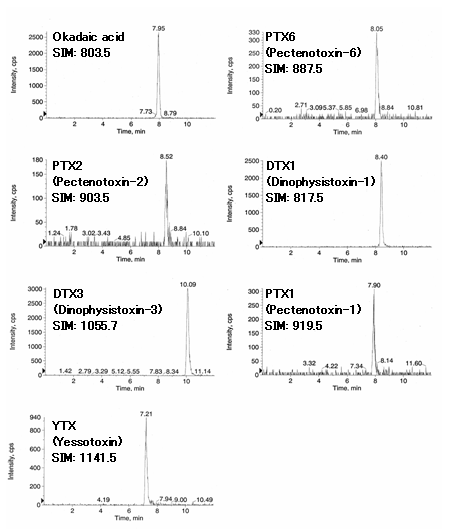
Sample preparation:
Add 9 mL of 90% (v/v) methanol to shellfish gut
Homogenize for 3~5 minuets
Centrifuge (3,000 rpm, 5 min)
Inject 5 micro-L of superfactant
Sample :
Okadaic acid
Pectenotoxin
Dinophysistoxin
Yessotoxin
Column : Shodex DE413-2B (2.0mmID*50mm)
Eluent : (A); 50mM HCOOH + 2mM HCOONH4 aq.
(B); 50mM HCOOH + 2mM HCOONH4 in (H2O/CH3CN=5/95)
0 to 5min, 20% (B)
5 to 12min, 20% (B) to 100% (B)
Flow rate : 0.2mL/min
Detector : ESI-MS(Negative)
Data provided by Dr.Toshiyuki Suzuki of the Fisheries Research Agency
Melamine (1,3,5-Triazine-2,4,6-triamine), a compound fraudulently used to falsely increase protein content in milk, is a toxic substance known to cause bladder and kidney stones in humans when chronically ingested. The discovery of melamine contamination in baby formula and in other food products has prompted the need for the development of suitable analytical methods for this substance. This chromatogram shows an application based on HILIC mode using Asahipak NH2P-50 4E.

Sample : Melamine 0.5mg/L, 5micro-L
Column : Shodex Asahipak NH2P-50 4E (4.6mmID*250mm) Eluent : CH3CN/H2O=75/25 Flow rate : 1.0mL/min Detector : UV(230nm) Column temp. : 30deg-C
Humic and fulvic acid extracts prepared from brown forest soil (Danto, Japan) and crumbly black topsoil (Inogashira, Japan) standard samples (provided by the Japanese humic susbtances society) were analyzed by size exclusion chromatography. Under these conditions, humic acids were found have a wide size distribution, while fulvic acid is much less dispersed than humic acids, as show by the molecular weight profiles. OHpak SB-805 HQ is a polyhydroxymethacrylate based size exclusion column with an exclusion limit of 40,000 MW (determined with a pullulan standard). It supports a wide pH range (pH 3-10), is compatible with organic solvents such as acetonitrile and methanol, and is used for the analysis of water-soluble macromolecules.

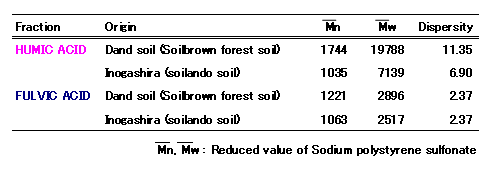
Sample : Humic substances, 30micro-L
Humic acid 0.02mg/mL
Fulvic acid 0.02mg/mL
Columns : Shodex OHpak SB-G (6.0mmID*50mm) + SB-805 HQ (8.0mmID*300mm) Eluent : 10mM NaH2PO4 + 10mM Na2HPO4(pH7.0) + 25% CH3CN Flow rate : 0.8mL/min Detector : UV(260nm) Column temp. : 40deg-C
Data courtesy of Associate Professor Nobuhide Fujitake,
Student Affairs Section, Graduate School of Agricultural Science, Kobe University
Several aldehydes were derivatized by DNPH (Dinitrophenylhydrazine) and analyzed using Asahipak ODP-50 4D.
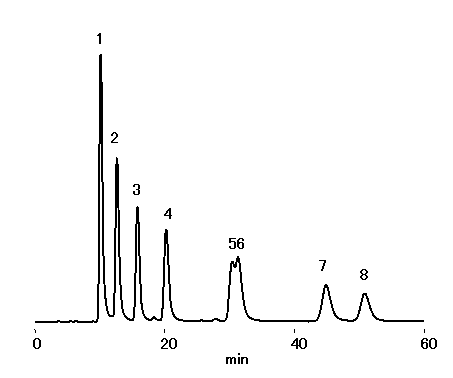
Sample : 10micro-g/mL each, 20micro-L
1. Formaldehyde-2,4-DNPH
2. Acetaldehyde-2,4-DNPH
3. Acetone-2,4-DNPH
4. Propionaldehyde-2,4-DNPH
5. Isobutyraldehyde-2,4-DNPH
6. n-Butyraldehyde-2,4-DNPH
7. Isovaleraldehyde-2,4-DNPH
8. Valeraldehyde-2,4-DNPH
Column : Shodex Asahipak ODP-50 4D (4.6mmID*150mm) Eluent : CH3CN/H2O=45/55 Flow rate : 1.0mL/min Detector : UV(360nm) Column temp. : 40deg-C
